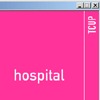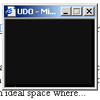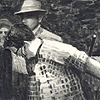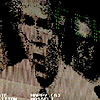 Originally
published
on
08/27/03
Originally
published
on
08/27/03"The Collective Unconsciousness Project (TCUP)" is a blog with a difference; it's a blog of dreams created by users visiting the website. The website isn't "a finished project, but an evolving framework that is both created and changed through interaction. It exists as both an online community and personal space."
Like all websites, "The Collective Unconsciousness Project" is a database collecting [and presenting] information in coherent forms. Yet, here, exploration of the content works in several ways allowing the user true freedom of movement into and through the space of the site. Users can continually click on the "continue" button to navigate through the database sequentially, or can click on a keyword related to the dream they are reading and jump to another dream with the same keyword. Added to this, users can make their point of departure anywhere in the collection of dreams by searching for a keyword and starting there.
Not alone do unexpected relations between dreams and the personalities of their contributors arise from the continual evolution of "The Collective Unconsciousness Project" but it manages to cleverly link different interpretations of ideas of the virtual. Firstly something is virtually real - like a dream, and secondly virtually real as in the more contemporary interpretation [of] virtual reality. Is "The Collective Unconsciousness Project" suggesting that virtual places such as websites are in fact idealized spaces originating from dreams? And do we as users feel that it achieves this by making the virtual more tangible, more navigable and shared?
:: Garrett Lynch ::
 Originally
published
on
08/25/03
Originally
published
on
08/25/03The shape conceptual art can take on the web can be quite unexpected at times. A good example is MTAA, who are net artists largely grounded on conceptual art from the Seventies, and whose work has already been appropriated by other net artists (linkoln.net: complex net diagram). While the strategies by these artists are intellectually intoxicating, it must be admitted that their artwork is dependent on a more established art aesthetic; that is, while their work is definitely dependent on, and defined by the net, this one is not inherently validated by it, but rather the net can be considered an extension of previous conceptual strategies. This does not mean that the work is "bad," but rather it is using an already established language to explore a relatively new medium, while preparing it for proper historization.
So, can conceptual art function on the net without citing allegorical premises or methodologies directly? And what is more important, would such attempt bring back a modernist methodology into play?
Enter k-hello.org, an art collective that has developed three conceptual projects. The conceptual approach is so obvious that the artists are able to describe the complexity of each project in three simple sentences:
"waste of time is software which lets the user write a phrase in an unreadable way, with 10000 webpages."
"cryptographever is an on-line tool which is able to discover secret messages hidden in pages publicized on internet."
"the six o is a mono-dimensional, conceptual videogame."
But the simplicity stops there. Each project is quite complex, and what is more interesting is that k-hello.org effectively combines downloading software for personal use, using online interfaces, and theorizing over pseudo code (three cultural elements that are specific to the internet), with a conceptual approach which could be considered modernist. Waste of Time is a software application commenting on the uselessness of the work of art, while exposing the net aesthetic that is vital to much of the progress in internet technology, which is to develop an application for the sake of running it. In cryptographever internet folklore is brought into play with a technological exploration of finding secret messages within webpages. And the six o, a video game, is as conceptual as it gets, as all the user has to peruse is the "idea," with simple html, something the hardcore conceptual artists from the seventies would definitely find appealing.
I must admit that I find MTAA and Linkoln.net's work to be interesting and important manifestations of art on the net; however, K-hello's approach while not overtly referencing a specific history, is refreshing by presenting a modernist aesthetic, where the work need not always reference that which contextualizes it, but rather it is defined according to the exploration of the form itself. I find this work to be very challenging to appreciate, as current deconstructive tendencies often demand aesthetic and/or political examinations; and it is in these two areas where ideological camps constantly split.
:: Eduardo Navas ::
 Originally
published
on
08/24/03
Originally
published
on
08/24/03Small but nicely formed, "UDO", a project by "MACHFELD" and "reMI" is a audiovisual network sniffing work that "transforms the heartbeat of the Internet into an emotionally entangling experience".
IP packets form the input for the UDO_system which transforms this data (initiated by the users connected) to audio and video output streamed in real time. The viewer becomes a user or collaborator by default; connection and presence becomes the sole criteria required to view a work which would not exist without at least one user connected. No users, no work, creating a sort of Berkelian ideal space where...
"Things are every moment annihilated and created anew. The objects of sense exist only when they are perceived: the trees therefore are in the garden, or the chairs in the parlour, no longer than while there is somebody by to perceive them. Upon shutting my eyes all the furniture in the room is reduced to nothing, and barely upon opening them it is again created." ("Principles of Human Knowledge", Berkeley, G.)
Here (in UDO) ideas of perception / presence are taken a step further, questioning the necessity of actual presence to perceive beyond
:: Garrett Lynch ::
 Originally
published
on
08/24/03
Originally
published
on
08/24/03Slowly the internet gets more and more accepted by artists that work with other mediums. An example of this is the project of the Dutch artist Marcel van Eeden, which consists of everyday putting a scan of a new drawing on his website. An interesting development, but the project would be even more interesting if he would offer high quality print pictures for download; an idea that just reminds me of Peter Halley's radical net art piece "exploding cell" with which users can compose and print a real Halley.
:: Peter Luining ::
 Originally
published
on
08/21/03
Originally
published
on
08/21/03Massive Attack
The forefathers of Trip Hop have been rocking the world for quite many years. Their thought provoking sounds most certainly challenge the listener. Their official URL is informed by the same attitude. It contains all of the basics of a music group site, yet is full of twists and turns, wrapped in a very sophisticated interface. Their critical stands fusses many aspects the site -- very sophisticated use of Flash. Their crowd stills from around the world are strikingly similar. I guess we are not that different from each other after all.
:: Ludmil Trenkov ::